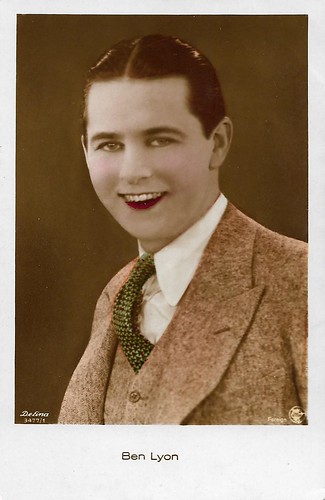
German postcard by Ross Verlag Foreign, no. 3477/1. Photo: Defina / First National.
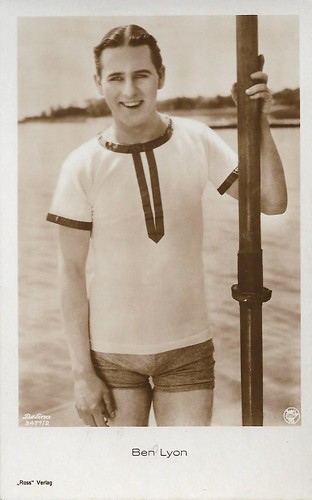
German postcard by Ross Verlag, no. 3477/2, 1928-1929. Photo: Defina / First National.
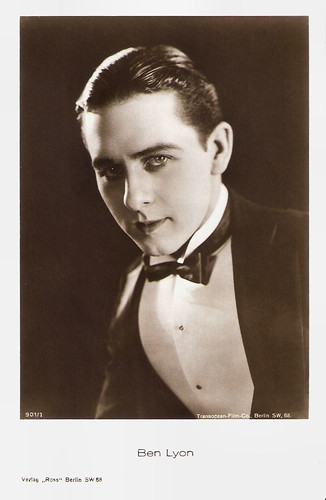
German postcard by Ross Verlag, Berlin, no. 901/1, 1925-1926. Photo: Transocean-Film-Co., Berlin.
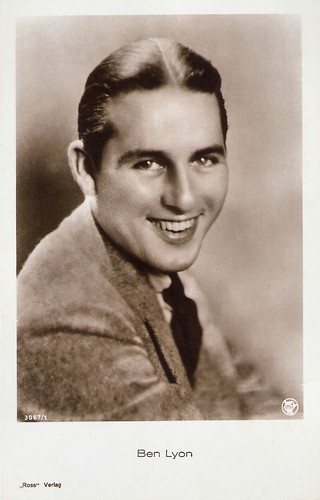
German postcard by Ross Verlag, Berlin, no. 3067/1, 1928-1929. Photo: First National.
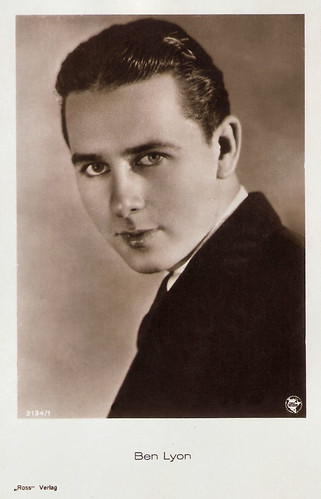
German postcard by Ross Verlag, Berlin, no. 3134/1, 1928-1929. Photo: First National.
A legendary aviation film
Ben Lyon was born in 1901 in Atlanta, Georgia, into a Jewish family. Lyon went to school at Baltimore City College. He began his theatre career as a 17-year-old alongside Jeanne Eagels. His early plays, in which he appeared in New York City (also on Broadway), include 'Mary the Third' and 'Wonderful Thing'.
Also at 17, he first appeared in front of the movie camera, and from the early 1920s, Ben Lyon appeared regularly in films. He attracted attention in the highly successful film Flaming Youth (John Francis Dillon, 1923) and became a leading man opposite such female stars as Pola Negri, Gloria Swanson, Colleen Moore, Barbara Lamarr, Viola Dana, Blanche Sweet, etc.
Many of his silent films in that decade also enjoyed some popularity in Germany and Austria, so Friedrich Zelnik offered him to play the male lead alongside Zelnik's wife Lya Mara in his screen romanc Das tanzende Wien/Dancing Vienna (Friedrich Zelnik, 1927). Filming took place in August and September 1927 in both Vienna (exterior shots) and Berlin-Staaken (studio shots).
It was not until the dawn of the sound film era that the actor with the distinctive center parting made his breakthrough in his homeland: he became instantly famous with the role of Monte Rutledge in Howard Hughes' legendary aviation film Hell's Angels (1930), in which Lyon, also an avid aviator in his private life, portrayed a war-volunteer pilot at the time of the First World War.
Despite numerous follow-up roles - Ben Lyon appeared in around two and a half dozen, consistently minor films over the next five years - and great popularity with the ladies, Lyon's career stagnated.
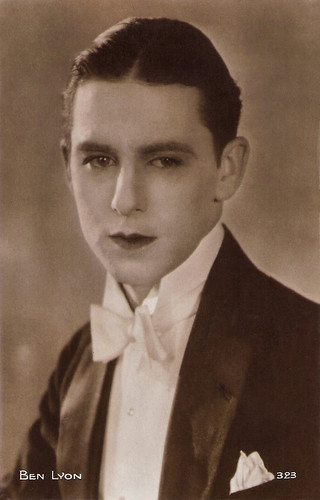
French postcard by Editions Cinémagazine, no. 323.
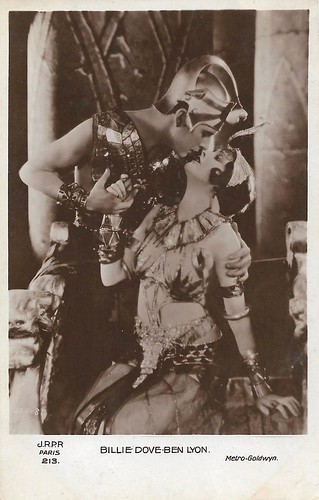
French postcard by J.R.P.R., no. 213. Photo: Metro-Goldwyn (sic: The film was a First National production, and was not produced by MGM). Ben Lyon and Billie Dove in The Tender Hour (George Fitzmaurice, 1927).
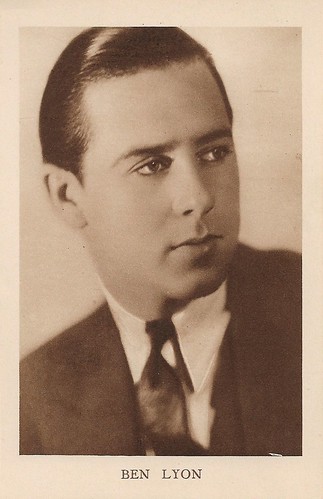
Belgian postcard by Weekblad "Cinema", Antwerp.
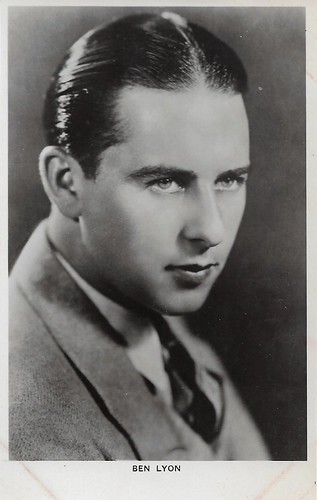
British postcard in the Picturegoer Series, London, no. 213a.
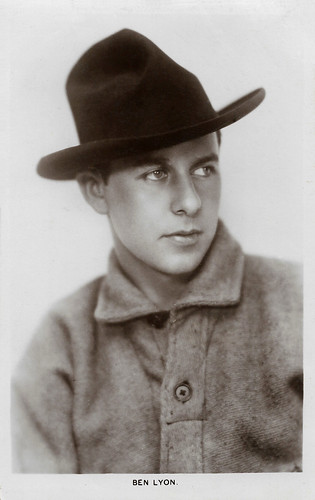
British postcard in the Picturegoer Series, London, no. 213b.
The man who gave Marilyn her first studio contract
Ben Lyon and his wife (since 1930), film star Bebe Daniels, decided to move to England in 1936. In London, he continued to work as a film actor but made a name for himself mainly as an entertainer on the radio and in music halls. His partner in song and dance was regularly his wife, Bebe.
During the Second World War, Ben Lyon temporarily reached the height of his popularity when, unlike many other US citizens, he did not travel home to the United States in the face of the German threat but stayed. In addition, he showed solidarity with the British through his work for the BBC and volunteered as a bomber pilot in the Royal Air Force.
In 1942, Ben Lyon was drafted into the American 8th Army Air Force with the rank of Lieutenant-Colonel. Between 1940 (shortly after the war started) and 1949, Lyon ran the BBC radio show 'Hi Gang!', a domestic sitcom featuring Lyon, Daniels, and Vic Oliver. From 1950 to 1961, Lyon also ran its sequel, 'Life with the Lyons', starring Lyon, Daniels, and their children. Between 1955 and 1960, Life with the Lyons was also broadcast on TV, while in 1954-1955 also two feature films were made.
At the end of the war in 1945, Lyon returned to civilian life and was appointed Executive Talent Director at the London branch of 20th Century Fox. From 1946 to 1948, Lyon was assigned to the same position in Hollywood. It was then that he gave Marilyn Monroe, whom he considered the next Jean Harlow, the leading actress of Hell's Angels, her first studio contract. Subsequently, until 1951, he was assigned as assistant to the head of production in London. Lyon was the subject of This Is Your Life in March 1963, when he was surprised by Eamonn Andrews at the BBC Television Theatre.
After Bebe Daniels died in 1971, Ben Lyon married actress Marian Nixon (1904-1983) in 1974. He died of a heart attack in 1979 at the age of 78 while on a cruise across the Pacific on Queen Elizabeth 2. He was interred at the Hollywood Forever Cemetery, next to his first wife, Bebe Daniels. In 1975, Jill Allgood, a good friend of Lyon and Daniels and collaborator on Life with the Lyons, published the biography 'Bebe and Ben'.

German postcard by Ross Verlag, no. 82/3. Photo: Defu. Lya Mara and Ben Lyon in Das tanzende Wien/Dancing Vienna (Friedrich Zelnik, 1927).
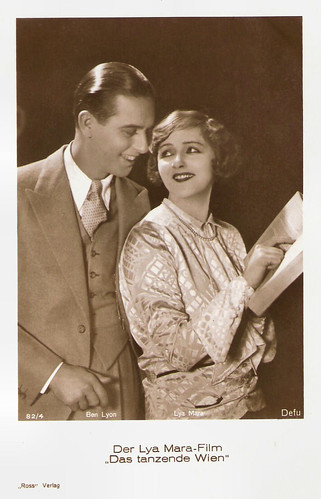
German postcard by Ross Verlag, no. 82/4. Photo: Defu. Lya Mara and Ben Lyon in Das tanzende Wien/Dancing Vienna (Friedrich Zelnik, 1927).
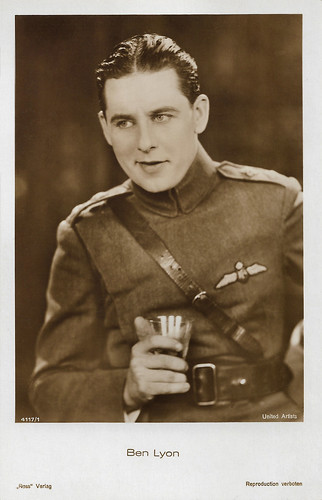
German postcard by Ross Verlag, Berlin, no. 4117/1, 1929-1930. Photo: United Artists. Ben Lyon in Hell's Angels (Howard Hughes, 1930).

German postcard by Ross Verlag, Berlin, no. 4435/1, 1929-1930. Photo: United Artists. Ben Lyon in Hell's Angels (Howard Hughes, 1930).

German postcard by Ross Verlag, no. 5539/1, 1930-1931. Photo: Radio Pictures. Ben Lyon and Bebe Daniels in Alias French Gertie (George Archainbaud, 1930).
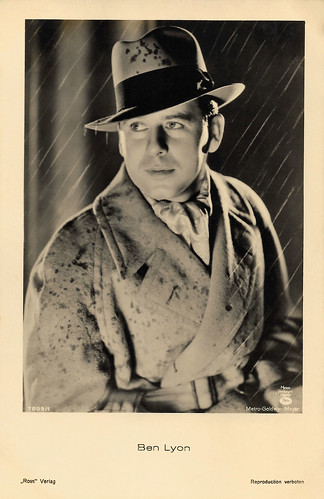
German postcard by Ross Verlag, no. 8909/1, 1932-1933. Photo: Metro-Goldwyn-Mayer.

British postcard in the Filmshots Series by Film Weekly. Photo: United Artists. Claudette Colbert and Ben Lyon in the pre-Code film I Cover the Waterfront (James Cruze, 1933).

British postcard in the Filmshots Series by Film Weekly. Photo: United Artists. Claudette Colbert, Ernest Torrence, and Ben Lyon in the pre-Code film I Cover the Waterfront (James Cruze, 1933). The other woman could be Claudia Coleman.

British autograph card. Bebe Daniels and Ben Lyon.

British postcard in the Picturegoer Series, London, no. D 502. Photo: Exclusive. Bebe Daniels-Lyon, Ben Lyon, Richard Lyon, and Barbara Lyon in Life with the Lyons (Val Guest, 1954).
Sources: Wikipedia (German and English) and IMDb.
This post was last updated on 17 April 2025.
No comments:
Post a Comment